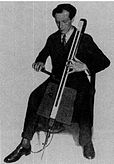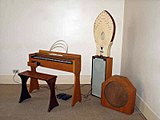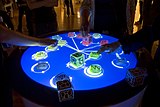Electronic musical instrument
An electronic musical instrument is a musical instrument that produces sound using electronic circuits. These instruments sound thanks to the production of an electrical, electronic or digital audio signal that is ultimately connected to a power amplifier that drives a speaker membrane, creating the sound that is heard by the player and the listener.
An electronic instrument may include a user interface for controlling the sound, typically by adjusting the pitch, frequency, or duration of each note. A widely used user interface is the music keyboard, which works similarly to an acoustic piano, except that on an electronic keyboard, the keyboard itself does not produce any sound. An electronic keyboard sends a signal to a synthesis module, computer, or other electronic or digital sound generator, which produces the sound. However, the separation between the user interface and the sound generating functions in what constitutes a controller (input device) and a musical synthesizer, respectively, is increasingly frequent, the two devices communicating through a description language. musical execution such as MIDI or Open Sound Control.
All electronic musical instruments can be considered as subsets of audio signal processing applications. Simple electronic musical instruments are sometimes known as sound effects; The line between sound effects and actual musical instruments is often blurred.
In the 2010s, electronic musical instruments are used in most musical styles. Within styles of pop music such as electronic dance music, almost all instrumental sounds used in recordings are electronic instruments (eg synth bass, synthesizer or drum machine).. The development of new electronic musical instruments, controllers and synthesizers continues to be a very active and interdisciplinary field of development. Specialized conferences are organized, highlighting the International Conference on New Interfaces for Musical Expression, to publicize the latest works, as well as to provide a platform where artists who perform or create music with the new electronic musical instruments can make themselves known., controllers and synthesizers.
Electrophone instruments are the last family to be included in the Sachs-Hornbostel classification, around 1940.
Mechanical-electrical or electromechanical instruments are musical instruments that mix mechanical and electrical elements to generate sound, such as the Hammond Organ or Mellotron.
First examples
In the 18th century, musicians and composers adapted a number of acoustic instruments to exploit the novelty of electricity. Thus, in the broadest sense, the first electrified musical instrument was the Denis d'or keyboard, dating from 1753, followed shortly thereafter by Frenchman Jean-Baptiste de Laborde's electric harpsichord in 1761. The Denis d'or;or consisted of a keyboard instrument with more than 700 strings, temporarily electrified to improve the sound qualities. The electric harpsichord was a keyboard instrument with electrically activated plectra (quills). However, neither instrument used electricity as a sound source.
The first electric synthesizer was invented in 1876 by Elisha Gray. The "Musical Telegraph" it was a fortuitous byproduct of her telephone technology when Gray accidentally discovered that he could control sound from a self-vibrating electromagnetic circuit and thus invented a basic oscillator. The musical telegraph used steel reeds oscillated by electromagnets and transmitted over a telephone line. Gray also incorporated a simple speaker device into later models, consisting of a diaphragm vibrating in a magnetic field.
An important invention, which later had a profound effect on electronic music, was the audion in 1906. It was the first thermionic valve, or vacuum tube, and it led to the generation and amplification of electrical signals, the broadcasting and electronic computing, among other things. Other early synthesizers included the Telharmonium (1897), Theremin (1919), Jörg Mager's Spharophon (1924) and Partiturophone, Taubmann's similar Electronde (1933) (1933), Maurice Martenot's Ondas Martenot (& #34;ondas Martenot", 1928), Trautwein's Trautonium (1930). The Mellertion (1933) used a non-standard scale, Bertrand's Dynaphone could produce perfect eighths and fifths, while the Emicon was an American keyboard-controlled instrument built in the 1930s, and the German Hellertion combined four instruments to produce chords. Three Russian instruments also appeared, Oubouhof's Croix Sonore (1934), Ivor Darreg's microtonal 'Electronic Keyboard Oboe' (1937) and the ANS synthesizer, built by the Russian scientist Evgeny Murzin from 1937 to 1958. Only two models of the latter were built and the only surviving example is currently at Lomonosov University in Moscow. It has been used in many Russian films - such as Solaris' - to produce unusual and 'cosmic' sounds. All of the above instruments, except those by Darreg and Murzin, are described in P. Scholes, The Oxford Companion to Music, 10th Ed. OUP, p.322</ref>
Hugh Le Caine, John Hanert, Raymond Scott, composer Percy Grainger (with Burnett Cross), and others built a variety of automated electronic music controllers during the late 1940s and 1950s. In 1959 Daphne Oram produced a novel method of synthesis, his "Oramics" technique, triggered by drawings on a 35mm film strip; was used for several years at the BBC Radiophonic Workshop. This workshop was also responsible for the theme for the television series Doctor Who a piece, largely created by Delia Derbyshire, which secured more than any other the popularity of electronic music in the UK.
Telharmonium
In 1897, Thaddeus Cahill patented an instrument called the Telharmonium (or Teleharmonium, also known as the Dynamaphone). Using tonewheel to generate musical sounds as electrical signals by additive synthesis, he was capable of producing any combination of notes and overtones, at any dynamic level. This technology was later used to design the Hammond organ. Between 1901 and 1910, Cahill had three progressively larger and more complex versions made, the first of which weighed seven tons and the last of which exceeded 200 tons. Portability was only achieved by rail and with the use of thirty wagons. By 1912, public interest had waned and Cahill's company was bankrupt.
Theremin
Another breakthrough, which aroused the interest of many composers, occurred in 1919-1920. In Leningrad, Leon Theremin built and demonstrated his Etherophone, which was later renamed Theremin. This gave rise to the first compositions for electronic instruments, as opposed to noisy ones and reused machines. The Theremin stood out for being the first musical instrument that was played without touching it. In 1929, Joseph Schillinger composed the First Airphonic Suite for Theremin and Orchestra, premiered with the Cleveland Orchestra with Leon Theremin as soloist. The next year Henry Cowell commissioned Theremin to create the first electronic rhythm machine, called the Rhythmicon. Cowell wrote some compositions for her, which he and Schillinger premiered in 1932.
Ondes Martenot
The 1920s have been called the height of the Mechanical Age and the dawn of the Electrical Age. In 1922, in Paris, Darius Milhaud began experimenting with "vocal transformation by changing the speed of the phonograph" These continued until 1927. This decade brought a host of early electronic instruments—along with the Theremin, there is the introduction of the Ondes Martenot, which was designed to reproduce the microtonal sounds found in Indian music, and the Trautonium. Maurice Martenot invented the Ondes Martenot in 1928, soon demonstrating it in Paris. Composers using the instrument ultimately include Boulez, Honegger, Jolivet, Koechlin, Messiaen, Milhaud, Tremblay, and Varèse. Radiohead guitarist and multi-instrumentalist Jonny Greenwood also uses it in his compositions by him and a plethora of Radiohead songs. In 1937, Messiaen wrote Fête des belles eaux for 6 ondes Martenot, and wrote solo parts for it in Trois petites Liturgies de la Présence Divine (1943–44) and the Turangalîla-Symphonie (1946–48/90).
Trautonium
The Trautonium was invented in 1928. It was based on the subharmonic scale and the resulting sounds were often used to emulate bell or gong sounds, such as in the 1950s Bayreuth productions of Parsifal. In 1942, Richard Strauss used it for the bells and gongs part at the Dresden premiere of his Japanese Festival Music. This new class of instruments, microtonal in nature, was slowly adopted by composers at first, but in the early 1930s there was an explosion of new works incorporating these and other electronic instruments.
Hammond Organ and Novachord
In 1929 Laurens Hammond created his company to manufacture electronic instruments. He went on to produce the Hammond organ, which was based on Telharmonium principles, along with other developments including early reverberation units.The Hammond organ is an electromechanical instrument, as it used both mechanical elements and electronic parts. A Hammond organ used rotating metal tone wheels to produce different sounds. A magnetic pickup similar in design to the pickups on an electric guitar is used to transmit the tones from the tone wheels to an amplifier and speaker cabinet. Although the Hammond organ was designed to be a low-cost alternative to a pipe organ for church music, musicians soon discovered that the Hammond was an excellent instrument for blues and jazz; in fact, an entire genre of music built around this instrument developed, known as the organ trio (usually Hammond organ, drums, and a third instrument, either saxophone or guitar).
The first commercially manufactured synthesizer was the Novachord, built by the Hammond Organ Company from 1938 to 1942. This instrument featured 72-note polyphony using 12 oscillators operating monostable divider circuits, a basic ensemble control system, and filters passes resonant bass. The instrument had 163 vacuum tubes and weighed 250 kg. The use of the instrument's envelope control is significant, as it is perhaps the most important distinction between the modern synthesizer and other electronic instruments.
Modern electronic musical instruments
The increase in power and decrease in cost of sound-generating electronics (and especially personal computers), together with the standardization of the musical performance description languages MIDI and Open Sound Control, have facilitated the separation of musical instruments into controllers and musical synthesizers.
The most common musical controller is the musical keyboard. Other controllers include the radiodrum, Akai's EWI and Yamah's WX wind controllers, the guitar-type SynthAxe, the html BodySynth], the Buchla Thunder, the Continuum Fingerboard, the Roland Octapad, various isomorphic keyboards including the Thummer, and the Kaossilator Pro, and kits like the I-CubeX.
Reactive
The Reactable is a translucent round table with an interactive backlit display. By placing and manipulating blocks called tangibles on the table surface, while interacting with the visual screen through finger gestures, a virtual modulator is activated, creating music or sound effects.
Percussa AudioCubes
AudioCubes are self-contained wireless cubes powered by an internal computer system and a rechargeable battery. They have internal RGB lighting and are capable of detecting the location, orientation and distance of others. The cubes can also detect the distances of the user's hands and fingers. By interacting with the cubes, you can manage various music and sound programs. AudioCubes have applications in sound design, music production, DJing, and live performance.
Kassilator
The Kaossilator and Kaossilator Pro are compact instruments in which the position of a finger on the touch pad controls two characteristics of the note; typically, the pitch is changed by moving from left to right, and the tonal property, filter, or other parameter is changed by moving from top to bottom. The touch pad can be adjusted to different musical scales and keys. The instrument can record a repeating loop of adjustable length, set to any tempo, and new sound loops can be layered over existing ones. This lends itself to electronic dance music, but is more limited for controlled sequences of notes, as the pad on a regular Kaossilator is featureless.
Eigenharp
The Eigenharp is a large bassoon-like instrument that can be interacted with via large knobs, a drum sequencer, and a mouthpiece. Sound processing is done on a separate computer.
XTH Sense
The XTH Sense is a portable instrument that uses the muscle sounds of the human body (known as a mechanomyogram) to create music and sound effects. When a performer moves, his body produces muscle sounds that are picked up by a chipped microphone worn on the arm or leg. The muscle sounds are then sampled live using a dedicated software program and a library of modular audio effects. The performer controls the live sampling parameters by weighing the force, speed, and articulation of the movement.
AlphaSphere
The AlphaSphere is a spherical instrument consisting of 48 touch pads that respond to both pressure and touch. Custom software allows you to indefinitely program the pads individually or in groups in terms of function, note and pressure parameter among many other settings. The main concept of the AlphaSphere is to increase the level of expression available to electronic musicians, allowing for the playing style of a musical instrument.
Contenido relacionado
Mercedes-Benz Necar 5
Electric generator
Silverware in the Viceroyalty of Peru












